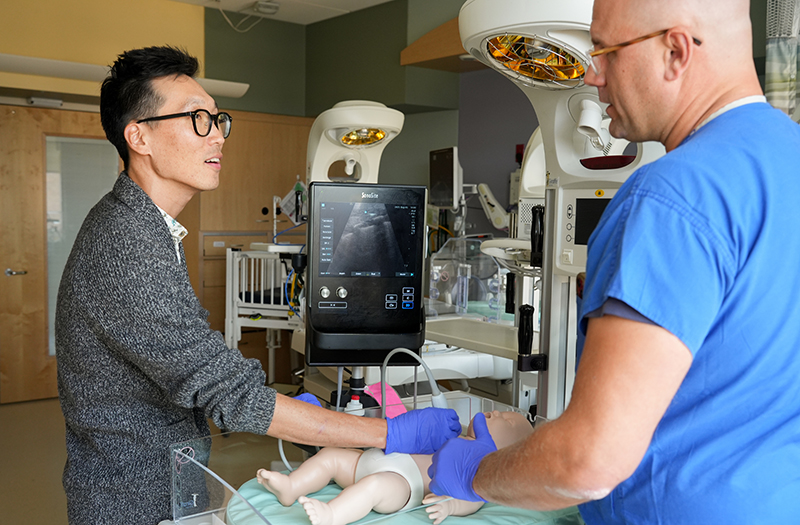
In the photo: Pediatric resident Tim Lee, MD, (left), and neonatologist Adam Bauer, MD, (right), discuss point-of-care ultrasound. Photo by Kate Feldt/Department of Pediatrics
When it first became available in the mid-1990s, portable ultrasound devices, known as point-of-care ultrasound (POCUS), were primarily used in emergency and trauma medicine, radically changing practices on the ground. POCUS could quickly locate internal bleeding or evaluate cardiac function, saving precious time. In the decades since then, the technology has generated devices that are smaller and faster, while image resolution has greatly improved. Further, just as for all technology that is widely adopted, prices have dropped. POCUS is now in use throughout medical fields.
Pediatrics is “playing catch-up” in POCUS use, according to Adam Bauer, MD, associate professor in the Division of Neonatology and Newborn Nursery. He is working to make that effort both rapid and effective. Bauer is the medical director of Neonatal-Perinatal Cardiac Coordination.
“As an attending physician seven years ago, I self-trained in POCUS with the assistance and collaboration of two physicians in the NICU [neonatal intensive care unit] and PICU [pediatric intensive care unit],” Bauer explained. Eileen Cowan, MD, associate professor in the Division of Neonatology and Newborn Nursery, and Awni Al-Subu, MD, associate professor in the Division of Critical Care and PICU medical director, were his POCUS collaborators with additional expertise from the Division of Cardiology.
In 2018, Cowan and Al-Subu, along with Ellen Wald, MD, then chair and professor in the Division of Infectious Diseases, put together a POCUS credentialing document for pediatrics. “It actually goes through specifically what you must do to be credentialed in each indication,” Bauer reported. “It’s a bit more general to pediatrics, but it works for neonatology and areas like that as well.” Bauer started teaching NICU fellows in POCUS in 2021.
“We are now trying to get pediatrics caught up to emergency medicine in use of POCUS. That is the goal. Even now, most medical schools have ultrasound offerings for their medical students, so we now have medical students coming in with POCUS training before residency. We are playing catch-up, trying to get people trained specifically in what we do in pediatrics,” Bauer said.
He is involved in a national POCUS group, the National Neonatal POCUS Collaborative; he was asked to join the steering and communications committees. The group is creating national guidelines, curricula, and more for POCUS use in the NICU.
“Our idea was to get this started in the residency program and go on from there,” he said. The local result is the POCUS residency elective with a one- or two-week option.
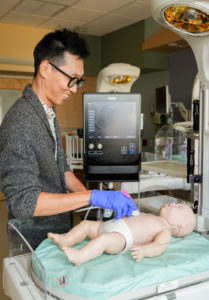
The latest resident to complete the elective, Tim Lee, MD, PL2 resident, is the first to complete the two-week option. Two more residents have chosen to complete the POCUS elective in the next few months.
Lee reported that he was exposed to use of POCUS in many medical settings, from the vascular access team using it for procedures to full-scale ultrasound by sonographers. His experience with the elective’s offerings affected his perception of what is possible.
“I was able to get hands-on POCUS experience, and it opened doors for future opportunities to practice and work with faculty who are trained in POCUS,” Lee said. “I intend to incorporate it into the rest of my residency learning so that I can use POCUS in clinical settings. The elective was only a taste of what I can do with POCUS, and I hope there will be a pathway for pediatric residents to get certified in POCUS.”
Bauer has generated considerable interest and excitement about the use of POCUS in neonatology and in other pediatric specialties. He enthusiastically explained its advantages and benefits. Because POCUS is portable, small, and a relatively inexpensive device to use, it can make many tasks easier and more accurate.
POCUS can make many procedures, such as lumbar punctures, intubations, IV insertion, and others that are potentially painful, more accurate. “There is literature that shows that from a procedural standpoint, the use of ultrasound is safer. You have a much higher success rate on first attempts regardless of the procedure you’re doing. And that in the end decreases pain,” Bauer explained.
“What I’m really trying to get people to do all the time is use POCUS for procedures. If you are already credentialed for the procedure, you don’t need POCUS credentialing to add on POCUS to see that you are in the right place. You are seeing the right thing — and that is very easy to teach,” Bauer said.
Bauer has been advocating for a norm of POCUS use department-wide. It has been a multi-divisional effort from the start: many division members already have extensive POCUS experience and promote general use and training of all members.
Clinicians’ observations about POCUS use in other department divisions
Many clinicians in pediatric divisions use POCUS. They describe its benefits, and how it is on its way to becoming an essential tool, as ubiquitous as the stethoscope.
Neonatal Intensive Care Unit (NICU)
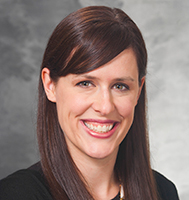
Eileen Cowan, MD, associate professor in the Division of Neonatology and Newborn Nursery, has been a long-time advocate of the use of POCUS in the NICU.
“I was one of the first faculty members in the NICU to bring POCUS here. When I started here in 2015, although the PICU (and of course the Emergency Department) was using POCUS, we were not using POCUS in the NICU. At that time, we did not even have a dedicated ultrasound machine for the NICU. In fact, many staff were hesitant to use POCUS on our vulnerable patient population, thinking that it might disrupt patient care or cause distress to our neonates. I saw that we were missing out on a wonderful opportunity for our patient population. I collaborated with Dr. Awni Al-Subu (PICU) and Dr. Adam Bauer (NICU) around 2017-2018 to come up with a way to implement POCUS in a structured way via a train-the-trainer approach. Dr. Bauer and I, along with a NICU fellow, also undertook a safety study in the NICU in which we assessed vital signs before and after POCUS, which demonstrated that POCUS was not causing distress to our neonates. That study was published in 2021. During the course of our study, staff became more comfortable with POCUS in the NICU; it was evident that it was not causing infant distress. Staff started to request POCUS on the neonates. We’ve done several workshops, training sessions, and projects since then. It has transformed how we take care of our babies for the better.”
Concerning the future, Cowan said, “POCUS use is likely to become the standard of care not only for the NICU, but for all pediatric specialties. I believe that the pediatric resident POCUS elective is imperative to our program and our patients. Not only should every resident get POCUS training, but I also believe that every fellow and physician should take this training.”
Pediatric Critical Care and Cardiology
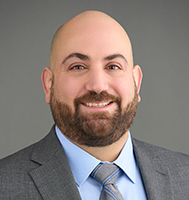
Awni Al-Subu, MD, associate professor in the Division of Critical Care, is the PICU medical director, as well as medical director of pediatric respiratory care at the American Family Children’s Hospital. He has been engaged in POCUS use in the department since he joined the faculty in August 2015.
“Since joining UW Health over a decade ago, I have prioritized the integration of POCUS across pediatric divisions, beginning with Pediatric Critical Care Medicine and Neonatology. Early collaboration with Drs. Eileen Cowan and Adam Bauer was instrumental in launching training initiatives for intensivists and neonatologists, which laid the foundation for structured training for fellows in both specialties. These efforts not only expanded POCUS use and proficiency among fellows, many of whom have gone on to pursue academic careers and become recognized experts in lung US and POCUS in general, but also emphasized faculty development. This aspect has been strongly supported by our Pediatric Cardiology colleagues, including Shardha Srinivasan, MD, professor, and Margaret Greco, MD, associate professor, both in the Division of Cardiology, whose contributions helped broaden POCUS expertise across disciplines. Overall, the integration of POCUS has significantly enhanced bedside diagnostics, procedural safety, and interdisciplinary collaboration within our pediatric care teams. Currently, we have a few pediatric intensivists who are credentialed in using POCUS for daily clinical work.”
Al-Subu considers the residency POCUS elective to be both essential and a success.
“The pediatric resident POCUS elective has been a transformative addition to our training program. In my opinion, it should be a mandatory two-week rotation. With Dr. Adam Bauer’s leadership and faculty across divisions, including Emergency Medicine, the elective continues to grow and provide residents with essential hands-on experience. POCUS is a rapidly expanding field, already embraced by many subspecialties. I believe it will become ‘the stethoscope of the future’ for pediatricians regardless of subspecialty. Universal POCUS training equips residents with diagnostic and procedural skills, preparing them for modern clinical practice and a less invasive diagnostic approach.”
Pediatric Emergency Medicine and Global Pediatrics
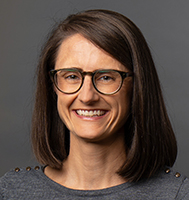
Natalie Tedford, MD, MSPH, is an assistant professor in the BerbeeWalsh Department of Emergency Medicine with an affiliate appointment in the Department of Pediatrics.
“In the pediatric emergency department, I use POCUS daily for rapid, bedside decision-making, whether that’s confirming intra-abdominal free fluid in trauma, guiding vascular access, or evaluating lung pathology.”
Tedford has also used POCUS in Malawi and in the Mountain West, as a tool for life-saving care when other tools were not available. “Learning and working with local partners in these low-resource settings, I was able to understand better how much impact POCUS has as a bedside tool,” she said.
She noted that the Department of Emergency Medicine’s Ultrasound Division has opportunities for providers to obtain credentialing in core applications recognized by national guidelines. Tedford’s assessment of the pediatric residency POCUS elective aligns with that of others in the field.
“The pediatric resident POCUS elective is a great introduction for residents to work on a bedside procedure/skill that enables them to incorporate POCUS thoughtfully into patient care. I believe every pediatric resident should have at least foundational POCUS training, regardless of their ultimate specialty. The ability to answer focused clinical questions at the bedside — quickly, safely, and without radiation — is an invaluable skill that can improve patient care in virtually every pediatric setting, from the ED to the NICU to global health work. I see POCUS as a future standard tool across many (if not all) pediatric divisions, much like the stethoscope or otoscope is today. The more we integrate it into residency training now, the more prepared the next generation of pediatricians will be to use it effectively and responsibly.”
Hospital Medicine and Global Pediatrics
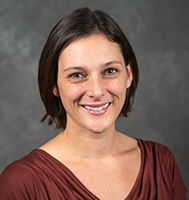
Ebba Hjertstedt, MD, MS, assistant professor in the Divisions of Hospital Medicine and Complex Care and Global Pediatrics, has a joint appointment in hospital medicine in the Department of Medicine. She is interested in developing and teaching skills in POCUS.
“I’m a Med-Peds hospitalist, I’ve been actively involved in advancing point-of-care ultrasound (POCUS) education in both departments’ divisions. Interest in POCUS has been growing steadily among our trainees, especially pediatric residents, and I’ve helped support their learning through the resident POCUS elective.
“Seeing a gap in structured POCUS training for our Department of Medicine pediatric hospital medicine fellows, I developed a dedicated elective specifically for them. It offers focused, hands-on experience with core ultrasound applications relevant to pediatric hospitalists and helps build a strong foundation for future clinical use.
“Our division has really benefited from the multi-divisional and departmental collaboration this work has encouraged. Increased visibility and shared resources have helped build momentum for integrating POCUS more broadly into our clinical practice. We’ve also partnered with colleagues in adult hospital medicine, family medicine, and emergency medicine to expand our educational opportunities and support cross-disciplinary learning.
“In addition to my local efforts, I’ve had the opportunity to teach POCUS internationally in Sweden and virtually in Uganda. It’s a tool that can make a real difference anywhere. That global perspective has reinforced the importance of teaching residents this skill early on. No matter where their careers take them, having a solid foundation in POCUS will serve them well.”
Hjertstedt considers the pediatric residency POCUS elective to be a necessity.
“Given how useful and versatile POCUS is, I believe all pediatric residents should receive at least some training in it,” Hjertstedt said. “It’s becoming more widely used in both adult and pediatric care, and I see it becoming a standard tool in many pediatric specialties. Through early training, we’re better preparing our residents to confidently use it in practice and keep up with the direction the field is heading.”